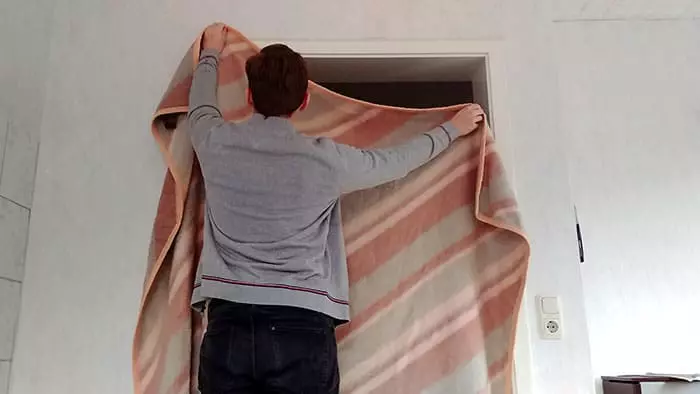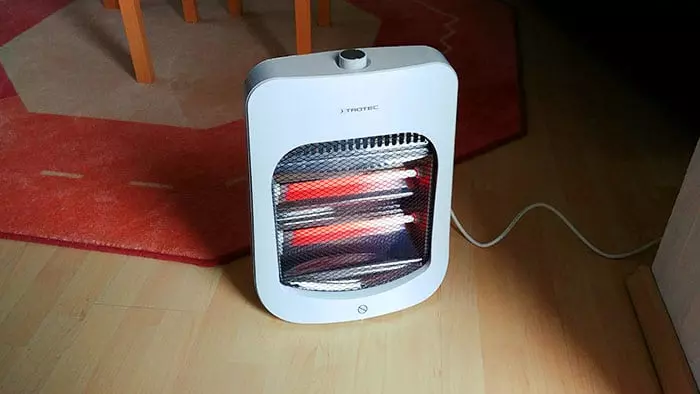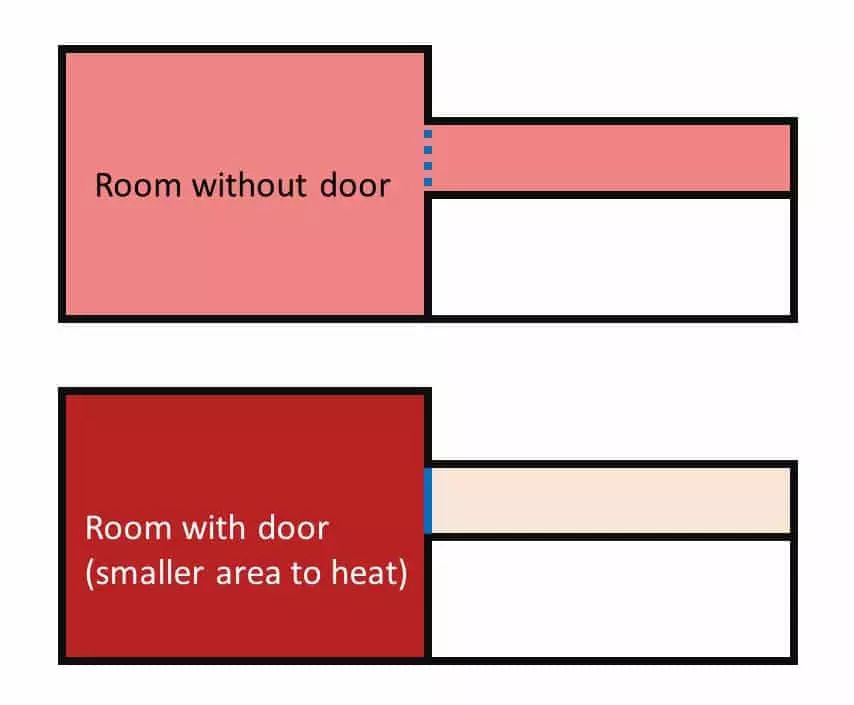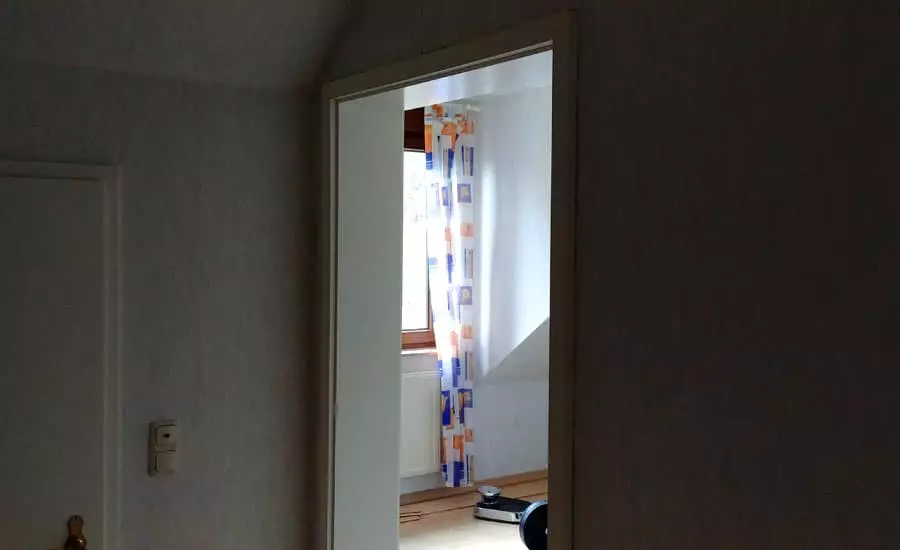How to keep heat in a room without a door? That’s one of the few questions humanity fails to answer. While we know everything about applied thermodynamics and heating options, we get a chill when we spend time in a room without a door.
Cold air comes in from the open door and you don’t know what to do about it.
But you don’t need to worry! You will stop freezing today!
How to keep heat in a room without a door
Keeping heat in a room without a door is easier than you think and I’m going to teach you how to do just that.
You’ll need to
- Find a way to keep hot air in the room.
- Consider additional heat sources.
- Upgrade your room a little.
In order to learn everything about how to keep the heat in a doorless room, keep reading!
Tips and Tricks
1. Keep heat using simple insulation
Here’s our first tip: Use a wool blanket to insulate the heat. As long as you leave your room open, there will be an increased airflow.
So, even if you heat the room, the temperature increases only slowly, because there will be a heat exchange with the hallway or other rooms.
Therefore, the very first thing you can do to keep heat in a room without a door is to tuck a wool blanket to the doorframe. You can either install it provisionally using a few nails to secure it to the open door frame, or you could use a curtain rod to hang the blanket there.
In this case, you could alternatively also use thick curtains instead of a wool blanket.
By using a wool blanket to insulate heat, you limit the airflow into and out of your room.
Effectively, the blanket limits the space you need to heat and creates a warm air pocket.

2. Use the radiator, but store the heat
In case the room you want to keep heat in has heating, here’s another thing you can do.
You’ve probably seen massage stones before. What if you use them to store the heat in your room?
I first had this idea when I noticed the rising air that comes out of a radiator. To keep the heat in a room without a door, one thing you can do is to limit the movement of the air.
By placing massage stones on your heating, the airflow is limited and the heat energy is stored in the stones.
Massage stones increase the heat storage in your room and heat will stay there for longer periods of time.
Of course, this is not only possible with hot massage stones. In theory, you could use all other kinds of stones as well. But I’ve found that they have a good heat capacity compared to regular stones you find outdoors.
Don’t try to place anything flammable on the heating! Stones are the safest heat storage.
3. Use an infrared heater for additional heating
I found that whenever I felt cold in a room even though I turned the heating on, a small, powerful heat source was missing.
So, I bought an infrared heater I can use as an additional heat source. The best thing about it is, that it’s portable and you can run it anywhere you want.
Infrared radiation heats objects, not air. It’s like the warm sun on an early summer morning. Even though the air is still cold, you feel the warmth of the sunrays. That’s similar to how infrared heat feels.
The best thing about it is, that whenever you want to keep the heat in a room without a door, you don’t rely on heating the air itself (which will eventually move out of the room). Infrared heat doesn’t heat the air. It heats precisely the object it shines on.
In my home-gym (which has no door), I use an infrared heater to quickly add some warmth to the room. To do so, I simply point it at my workout area and it’ll keep me warm while I’m working out.
Other heaters would heat the air, which would quickly disappear.
In a room without a door, an infrared heater is an awesome investment for additional heat.

4. Carefully test the heater
If you use an external electrical heater in your room that has no door, please carefully test it before using it extensively.
I’ve found that rooms without doors are often side-rooms that you don’t use that often. So, the wall outlets are not built in the safest possible way.
For simple safety reasons, you should test the heater.
To test it, here’s what you can do:
- Start heating with the lowest power settings. Leave the heater on for 30 minutes. This shows you whether the outlets can handle the current your space heater draws.
- Increase the temperature of your heater and leave it on for another 30 minutes. Have a window open and make sure the room is vented. By doing so, your heater will off-gas. Harmful gases that could be dissolved in the materials of the heater will party evaporate.
Congrats!
Your heater is now ready to heat. Don’t worry, you have to do this test only once. After that, you can run your heater without worries.
5. How to set the right temperature in a room without a door
“Heating and cooling account for 50% to 70% of the energy used in the average American home.”
To make sure you heat your room efficiently, you should set the right temperature on your heating.
Too high heat will be inefficient: As long as your room has an open door, the hot air will not stay.
Too low heat will not be enough to heat your room properly.
I’d suggest setting the temperature of your heater (depending on the outdoor temperature) between 60-80% of full heat.
But if you have your door “closed”, as suggested in the first tip, you can lower the power settings to 40-60%.
As you see, as soon as you have insulation (like a wool blanket that covers the open doorframe), you don’t need to waste so much energy on heat anymore. The insulation will trap the warm air and keep the heat.
6. How often and for how long do you enter the room?
Is it a room in which you spend time regularly? How much time do you spend there? Just a few minutes a day or many hours?
I’m asking because if you spend only a few minutes there every day or you go there only occasionally, you’ll need a quick heater that is able to provide heat as fast as possible.
For example:
My home gym has no door. Turning on the heating doesn’t help at all, because after the time it takes to heat up, I finished my workout.
For such a case, where you don’t spend long durations of time in your room, a quick heater that can provide heat instantly will help you a lot.
That’s why I use an infrared heater. It reaches full heat after 15 seconds.
In case you spend more time in that room, you’re just fine with the normal heating. It’ll take more time to heat up, but you don’t need to get another portable heater.
7. Point the heater in the right direction
This might be an obvious tip, but if you forget about it, your room will lose heat rapidly. To keep the heat in a room without a door, you have to place your heater in such a way that it points toward the center of the room.
Therefore, the heat will accumulate in the center and stay there.
In contrast, if you point your electric heater toward the open door, you’ll lose a lot of heat. Especially if you use an infrared heater, the radiation that shines through the open doorframe is lost forever.
8. Preheat the room
Do you know you want to spend an hour or two in that room? To feel more comfortable, preheat it.
Even if there’s no door, preheating will help a lot in keeping your room warm. And you don’t need to wait until the heating turns on.
I love to preheat my living room when I know that in half an hour I want to read a book there.
Preheating is only necessary when you’re producing the heat using your home’s central heating. Generally, it is slow and needs some time to get hot.
If you want to heat using an electric space heater, you don’t need to preheat at all. Usually, they are very fast and heat up within a minute.
So, instead of preheating, you could also turn the central heating on and then boost the heat for a few minutes with a space heater. This will give you quick heat in the first few minutes and when the central heating is hot, you can turn off your portable space heater.
9. Which temperature is too much?
Sadly, there is no perfect answer to this question. Even if I would name a temperature that suits me best, it will not be the best temperature for you, because we’re all different.
As we previously discussed, you should set higher heat settings to make up for the heat that escapes out of the door.
For finding the perfect temperature, you can start with around 75% of the heating power:
When your heater has 5 power settings, use power level 4. Or when your heater has 1500W, set it to around 1100W (if possible).
Mostly, that’s a good level of heat. Then, you can increase or decrease the temperature according to your needs.
If you have set-up a blanket that covers the open doorframe as I suggested in tip 1, you can lower your settings.
Usually, you don’t need to max out your heating power settings when you’re using powerful heat sources like the central heating or propane heaters.
However, when you’re relying on less powerful electric heaters, you can run them on full heat.
10. Are convection heaters good in doorless rooms?
Convection heaters are heaters that distribute the heat using the movement of air. Convection heaters are, for example, your central heating or electric ceramic heaters.
Generally speaking, in rooms that don’t have a door, using a convection heater is not a good idea. Even if they produce heat effectively in closed rooms, in doorless rooms, they are not the best choice.
Why?
Because if you heat up air that can leak through an open door, the hot air will escape because it wants to mix up with cold air. That’s simple physics.
It’s like you’re trying to swim up a waterfall. You can try to do it, but it’s not the best way to get up there. The best way is to get a helicopter.
In our case, the helicopter that we need to keep our room warm, is an infrared heater. It does not heat the air, but the objects it shines on.
Therefore, infrared heaters are the most efficient types of heaters to keep warm even with an open door.
11. How to properly size a heater for a room without a door?
To stay warm in a room without a door, an infrared heater is a great investment. Honestly, my infrared heater was one of the best presents I’ve ever got (thanks to my girlfriend!).
But which size of a heater do you need to keep warm in a room without a door?
I love to spend time reading books in our living room. When it’s cold, I grab my infrared heater and point it at my feet. It makes you feel so comfortable.
My heater has only 800W of power. But that’s definitely enough to keep me warm in a room with an open door.
However, if you want to heat a room for multiple persons, you should definitely get a bigger type of heater.
Generally speaking, 1500W heaters are the best choice. Most of the time, they provide enough heat. And you can even save energy by lowering the power settings to 1000W or 750W.
If you want to calculate the exact amount of power your room needs, here’s how you can calculate it.
“Estimate 10 watts per square foot and multiply the square footage of the room by 10. A room with 144 square feet will require 1,440 watts.”
Pay attention: When your room has no door, you have to not only count the square footage of that room but also the square footage of the room it’s connected to!
Example:
You have a room with 144 square feet that connects to a hallway with 50 square feet. That means that the total amount of space your heater needs to heat is 144 + 50 = 194 square feet.
12. Use propane heaters in rooms without electricity
I’m a big fan of propane heaters. Even though they work by heating up the air (which wastes energy), they are very practical for heating rooms that don’t have electricity.
All you need to do is to hook up a propane tank and you’re ready to go.
So, if you’re looking to heat a garage or a greenhouse, a propane heater is a great choice.
But for rooms without a door, infrared heaters will be superior. They are more efficient.
13. Wear slippers
To keep warm in a room without a door, please wear slippers. Slippers will insulate your feet and block off cold air that enters from outside.
If the room you’re in isn’t warm at all, slippers will at least double your wellbeing (at least they do that for me).
If you’re not a slippers-type of person, you should still give them a try. I bet you’ll not regret it!
Having cold feet is one of the main reasons, you’re feeling cold overall.
14. How will heating a room without a door affect your energy bill?
From an engineer’s perspective, heating a room without a door affects your energy bill in the same way as simply heating a room of a bigger size.
Let’s revive the previous example:
A 144 square feet room that is directly connected to a 50 square feet hallway is exactly the same as one 194 square feet room.
Assuming that the hallway has no own energy source we can say that the hallway increases the total size of the room by roughly 25%.
Answer: The energy bill will increase according to the size of the room without a door plus the rooms that it is connected to.
This way you can also see the benefit of insulation: By separating the hallway and your room (for example using a blanket or by adding a door), you’ll decrease the size of the area to heat by 25% and save money accordingly.
 The area you need to heat decreases when you install a door. This cuts your energy bill.
The area you need to heat decreases when you install a door. This cuts your energy bill.
15. Close other rooms
Rooms without doors are usually connected to other rooms or a hallway. By closing all the doors of the rooms it is connected to, you limit the amount of space you need to heat.
If you keep all the rooms in your apartment open, the heated air will distribute among these rooms.
Therefore, you need more energy to keep the temperature up and it will take much longer to heat the room you’re in.
Always make sure you don’t unnecessarily heat space.
16. Put down a big carpet
This one does not directly keep the heat in your room without a door, but it will make you feel so much better.
“If your floors feel cold, put down a rug. It sounds simple, but it’s more helpful than you may think. ‘Not only will a rug keep your feet from feeling cold, but it actually adds a layer of insulation.’”
If you don’t have a big carpet yet, get one! It insulates your feet from the cold, bare floor.
You probably know that hot air rises. That’s why cold air accumulates on the floor. Therefore, you’ll feel a lot colder than it actually is.
When you put down your feet on the carpet, small warm-air-pockets form on the sole of your foot, which the carpet traps. These pockets provide additional warmth and make you feel a lot better.
When I first installed a carpet in my student’s dorm, it was a total game-changer. It improved my life quality a lot.
As long as you don’t have a carpet on your floor, you’ll feel unnecessarily cold.
17. Add a door
If you’re regularly spending time in a room without a door, consider simply adding a door. I know this one is obvious and there might be reasons why there is no door yet.
However, in the long term, having a door will always pay for itself. It reduces the energy bill significantly.
Even if you don’t do the work yourself and hire someone to install the door, it will be worth it in the long run.
A door is the best and simplest form of insulation between rooms. If you don’t have one, you’ll always heat air that distributes among other rooms. It’s a waste of energy.
18. Talk to your landlord if you rent the home
The previous tip (install a door) doesn’t really work if you don’t own your home. If you’re renting, you can’t decide these things yourself.
But:
Why don’t you speak to your landlord? I’m sure he will understand the issue.
If he is okay with adding a door, he might even pay for it, because it’s his property.
Explain the need and desire to him in a way he understands. Landlords are always interested in increasing the value of their property.
By adding a door, he will increase the worth of his home (even if it’s only slightly). That’s why most landlords agree on such little upgrades.
For them, the money does not disappear, but it ends up being part of their property. And your landlord can tax write off the expenses! That’s why it’s cheaper for him to install a door than it is for you.
19. Consider a wall carpet
Wall carpets - some people love them, some people hate them. If you’re one of those people who think that wall carpets can look good, consider getting one in your room without a door!
Wall carpets don’t have to look like lost ancient artifacts. They can actually add a nice look to your room.
A wall carpet also insulates walls and effectively keeps the heat from leaking through your walls.
But before you install a wall carpet, please somehow cover the open door first. First, make sure you cover it with a blanket or provisionally install a (cheap & simple) door.
Otherwise, the warmth that you keep thanks to your wall carpet escapes through the open door.
20. Keep warm with the right clothes
To keep warm in a room without a door, you don’t always have to heat the room. This brings a lot of hassle:
- It increases your energy bills.
- You’d have to install things to insulate the room.
- Maybe you’d need an electric space heater.
Why don’t you simply dress warmer?
My parents always said:
“There’s no bad weather, only bad clothing!”
my parents (every time I complained about rain or cold)
Make sure you wear slippers. Put on another pullover. Wear two layers of socks.
If you dress warmly, you don’t need to worry about how to heat effectively. Of course, you want to heat the room a little, but you don’t need to waste time on designing the optimum energy plan.
21. Health and wellbeing are more important than saving energy
If you, however, spend lots of time in your room, make sure you don’t get too greedy with your energy bill.
Your health and wellbeing are more important than saving energy.
“Cold homes can cause high blood pressure and even heart attacks and pneumonia. They can also lead to social isolation, loss of sleep, stress and mental illness.”
Make sure you feel good in that room. Turn up the heat if you feel cold. Don’t limit yourself, because you want to save a few cents on your electricity bill.
Spending time sitting in a cold room is a waste of life quality and decreases your enjoyment of every-day things.
You can’t properly read a book if you feel cold. And you can’t watch TV if you feel cold.
So:
Turn up the heating, grab a blanket and make yourself comfortable!
Conclusion - How to keep heat in a room without a door
Answer: To keep heat in a room without a door, the best thing you can do right away is attaching a wool blanket to the doorframe. It acts as a windshield and limits cold air that enters your room. Also, it decreases the area you need to heat and increases efficiency.
If you had to pick only one tip from this list, that will instantly help you keep the heat in your room without a door, I’d definitely use the wool blanket.
In case covering the open doorframe is not possible, you should at least have a powerful infrared heater prepared that supplies additional heat and keeps you warm even if the door is still open.
